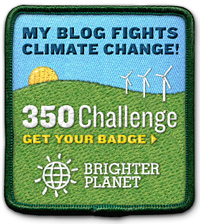 We know that you voted for Earth on Saturday 28 March and turned off your lights. We enjoyed the hour playing cards by candle light and of course we happily survived, although there may be some candle wax on the cards.
We know that you voted for Earth on Saturday 28 March and turned off your lights. We enjoyed the hour playing cards by candle light and of course we happily survived, although there may be some candle wax on the cards.Earth Hour was a great opportunity to show our concern over global warming and to get those billion votes that they are hoping to take to the Global Climate Change Conference in Copenhagen 2009. Remember though that during that hour we also did not need much electricity in our homes or workplaces and therefore we were able to burn less fossil fuel and reduce our CO2 emissions.
Assuming the Earth Hour goal was reached and 1 billion people around the world turned off their lights for the full hour we can estimate that about 450 million pounds of carbon dioxide were kept out of the atmosphere, which is the equivalent of taking 350 million cars off the road for that hour. This is more than the total number of registered cars in the USA.
As we thought about these savings, we started talking about clean coal. We have heard a lot about it, particularly from the energy companies. They suggest that clean coal is as viable a solution to global warming as any other natural environmental energy such as solar and wind.
After doing some research here are 7 facts about clean coal.

- We all know that coal is a fossil fuel that is used mostly by energy and electric companies in power plants and is burnt to create steam, which turns turbines and thereby creates electricity. Burning coal releases CO2 (carbon dioxide) into our atmosphere. You can see it pouring out of a power plant smoke stack.
- One aspect of clean coal technology is to literally wash the coal with liquid prior to burning. This removes the unwanted impurities. Wet scrubbers are also used to remove sulfur dioxide (a major cause of acid rain) by spraying the coal with limestone and water.
- Clean coal technologies also use low nitrogen oxide burners and gassification which convert the coal into a gas to burn. This is said to reduce the amount of coal burnt.
- Any method used to clean coal will still result in CO2 emissions which will then need to be stored.
- Carbon Dioxide capture and storage is the technology that proponents of clean coal seem to be most enthusiastic about. They suggest that CO2 emissions can be captured and kept out of the atmosphere . The captured CO2 needs to be collected in secure containers. The CO2 is then stored in 2 possible ways. Either under the ground by injecting the CO2 into depleted oil or gas fields and seams, or injecting liquid CO2 into the ocean 500 to 3000 meters deep.
- Storage methods (underground or ocean) must be able to contain the CO2 until peak emissions subside. This will take hundreds of years.
- The environmental effects of all the forms of storage are largely unknown. By injecting CO2 into the earth we may cause changes in the soil and pressure under the earth, and by injecting liquid CO2 into our Oceans we could damage marine life. Any form of storage will need to be carefully prepared and monitored.
Now that we have some facts, we are not convinced. With clean coal technology, we are taking the coal burning, CO2 emissions, problem and shoving it under the bed so that we can ignore it. Global warming is not "somebody elses problem" . We need to step up now and change the way we create and use energy. Drop the idea of clean coal technology and rather spend that research money on solar and wind power technology. Forget about capturing and storing CO2 and fund research into battery technology to store the natural energy sources that we have available.
Of course, you know that you can do your part too. Reduce your waste, Recycle whatever you can and Reuse as much as you can.
We still have a long way to go. I met with a friend to catch up on Thursday, at a local coffee shop. The coffee shop was full, with a line out the door, as it usually is, but unfortunately I was the only customer using my own mug. Everyone else was using a paper cup and all of them had plastic lids. There is an easy solution to this waste. If you do not have a mug then get one at http://www.gogreenmug.com/ and always remember to bring it with you to coffee shops.
Have a great week and reduce your waste.










